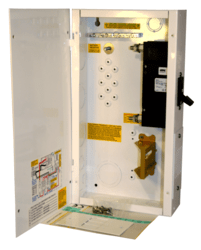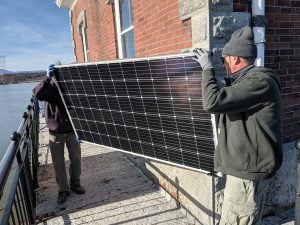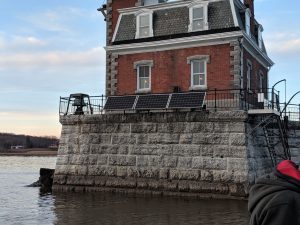
Backup Power, Batteries, Charge Controllers, Off-Grid Solar, Renewable Energy, Solar Panels, Solar Power
The Hudson-Athens Lighthouse in Upstate New York was first commissioned in 1874. It served as a guiding light for ships navigating the busy lanes passing by Hudson and Athens in the late 19th century, helping them avoid the Middle Ground Flats that separates the two cities. The lighthouse was manned from its inception until 1950, housing six different keepers and their families in that time. The lighthouse was automated in 1949, and its beacon is still owned and maintained by the U.S. Coast Guard. The Coast Guard was responsible for the entire property until 1984 when then New York Governor Nelson Rockefeller recommended they begin looking to lease the property to a non-profit group, that would maintain the site for the benefit of the public.

Aerial view of the Hudson-Athens Lighthouse, with the Middle Ground Flats to the North. The active channel runs north-south to the East (right) of the Flats. Used with permission from HALPS.
With this in mind, a group of citizens in the neighboring counties founded the Hudson-Athens Lighthouse Preservation Society (HALPS). This non-profit organization would handle the physical upkeep of the property, and commit to protecting and promoting its historical value. After leasing the property from the U.S. Coast Guard for 16 years, HALPS was granted the deed to the Lighthouse in 2000, making it the sole owner of the property. To learn more about the history of the Hudson-Athens Lighthouse, its light keepers, and the surrounding area, visit their website: http://www.hudsonathenslighthouse.org/.
A Decorated Lighthouse

The winter sun sets behind the Hudson-Athens Lighthouse, bedecked in holiday lights. Used with permission from HALPS.
In addition to making the lighthouse and its history accessible to the public, the Society has delighted residents of the surrounding counties for more than 20 years by decorating the property with holiday lights each winter season. Unfortunately in September of this year, the underwater power cable that had supplied electricity to the lighthouse malfunctioned. Luckily the navigation light in the tower was unaffected, as the Coast Guard had already installed a PV system to power it years ago. In order to power the rest of the house and finish their summer tour schedule, the volunteers of HALPS worked with a local electrician to set up a generator. With a stopgap in place they began looking at solar power as a long-term solution. With help from the Hudson Power Boat Association, they began designing a new off-grid solar power system.
altE worked with Joe Kenneally, lead volunteer at the Hudson-Athens Lighthouse Preservation Society, and Peter Rowland, a local electrical engineer, to design a system that would ensure the holiday lights stayed on all winter long. One crucial limitation – each winter everyone pulls their docks ashore to protect them from ice damage, and the Coast Guard breaks ice in the channel so that river traffic can safely reach Albany. Launching a boat on an ice shelf is very dangerous, and walking across is impossible. The Society knew they only had a few months, or maybe weeks, to install the off-grid solar system before losing access the site. With a deadline fast approaching, Joe, Peter, and their fellow volunteers set out to save a holiday tradition.
Designing The System
Some quick math showed the maximum daily load of the holiday lights would be roughly 1250Wh, and that mounting PV modules on the side of the lighthouse could get them about 3 peak sun hours per day. We landed on a 3-panel array using Seraphim 375W Monocrystalline modules. Although slightly oversized for the anticipated load, this will hopefully provide the Society some room for expansion, and ensure that there would be adequate solar to recharge the batteries after a couple days without sun (an important consideration with off-grid solar).
The volunteers fashioned their own racking system to be mounted to the fence, allowing them to adjust the panels to the desired tilt, thus optimizing the system for winter production.
 The panels were wired in parallel using a Midnite PV3 combiner box. The benefits of this decision are twofold: first of all, it allowed for the use of a slightly lower-voltage charge controller (Victron Smart Solar 100V 50A Controller), which helped keep the overall cost of
The panels were wired in parallel using a Midnite PV3 combiner box. The benefits of this decision are twofold: first of all, it allowed for the use of a slightly lower-voltage charge controller (Victron Smart Solar 100V 50A Controller), which helped keep the overall cost of  the system down. Secondly, the parallel wiring helps to mitigate the negative impacts of partial shading. That is, if one panel is shaded, the output of the other two modules would not be impacted.
the system down. Secondly, the parallel wiring helps to mitigate the negative impacts of partial shading. That is, if one panel is shaded, the output of the other two modules would not be impacted.
Given that the system would not be monitored all winter, it seemed important to put certain protections in place that would prevent over-discharging the batteries, which would greatly reduce their overall lifespan. Therefore, another Victron product known as the Smart Battery Protect was  installed inline between the batteries and the inverter to prevent the batteries from ever being drawn below an unsafe level. Although it was important to the volunteers of HALPS that the lights stay running all winter long, protecting the battery bank took precedence. As a result, if there is ever an extended period without sun, the Battery Protect will disconnect the inverter from the batteries, thus preventing it from continuing to reduce their voltage – until the panels get a chance to charge the batteries back to a safe level. Without this added protection, multiple cloudy days could potentially reduce battery voltage enough that the charge controller would no longer turn on, meaning that the system would not operate until someone accessed the lighthouse to recharge the batteries using an alternate charging source. Needless to say, this would be troublesome for any remote off-grid system.
installed inline between the batteries and the inverter to prevent the batteries from ever being drawn below an unsafe level. Although it was important to the volunteers of HALPS that the lights stay running all winter long, protecting the battery bank took precedence. As a result, if there is ever an extended period without sun, the Battery Protect will disconnect the inverter from the batteries, thus preventing it from continuing to reduce their voltage – until the panels get a chance to charge the batteries back to a safe level. Without this added protection, multiple cloudy days could potentially reduce battery voltage enough that the charge controller would no longer turn on, meaning that the system would not operate until someone accessed the lighthouse to recharge the batteries using an alternate charging source. Needless to say, this would be troublesome for any remote off-grid system.
As for the batteries, the volunteers took advantage of the long cycle life and wide operating temperature range of the Outback 200 Nano Carbon batteries. With a bank of 4 batteries, they achieved a total of 356Ah at 24V, providing an estimated 2 days of autonomy at 50% depth of discharge, given their anticipated daily load.

All DC wiring was done inside the Midnite Mini DC disconnect box, which housed the charge controller and inverter breakers – keeping the system wiring neat and compact. Finally, the inverter we chose  for the job was the 600W 24V Samlex PST Pure Sine Wave Inverter. By using an inverter just large enough to handle the maximum continuous current rating of the lights, daytime ghost loading was reduced. This makes for a more efficient system.
for the job was the 600W 24V Samlex PST Pure Sine Wave Inverter. By using an inverter just large enough to handle the maximum continuous current rating of the lights, daytime ghost loading was reduced. This makes for a more efficient system.
Installation

HALPS volunteers team-lift one of the three Seraphim PV modules that are now powering the holiday lights. Used with permission from HALPS.
HALPS’ lead volunteer and 35-year member Joe Kenneally wrote of the install:
Six men went out to the lighthouse Saturday morning, where the week before we made trips delivering supplies to build a solar system. Eight hours later six tired, hungry men returned happy, knowing the tradition of the Christmas lights on the river continues.
The system was installed and commissioned on November 22, just in time to flip the lights on for the holiday season, as has been the tradition for two decades. With winter quickly approaching, and knowing there would be no mid-season maintenance for the new solar system, the volunteers decided to install slightly fewer lights than in years past. That said, Joe is confident that next year the lights will be back “bright as ever!”

View from the departing boat of the completed PV install. Used with permission from HALPS.
Overcoming time constraints, budget limits, and other obstacles, the Society kept the local holiday tradition for Columbia and Greene counties alive – all thanks to some dedicated volunteers, lots of technical know-how, and a little help from the sun!

Grid problems? What grid problems? Happy Holidays! Used with permission from HALPS.
